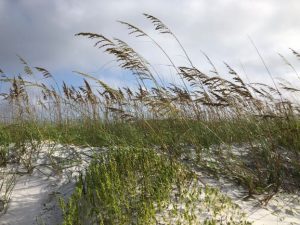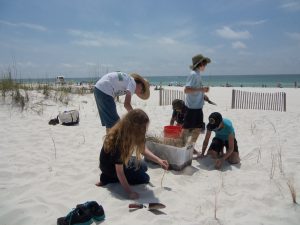
Walking along any Panhandle beach, the first thing you’ll notice growing on the dunes are the tall, stately sea oats (Uniola paniculata). Just about any visitor to our coasts knows the name of these grasses, but they may not realize how crucial they are to the entire ecosystem. These grasses serve as anchors for the whole dune system, and their roots can grow up to 40 feet deep. Sea oats spread horizontally via underground rhizomes, but may also sprout via seed.
Acclimated to the harsh environment of full sun, constant salt spray, and dry soils, sea oats also serve as a food source to beach mice, rabbits, and a variety of birds. When a young sea oat starts to grow upright, blowing sand from the beach hits the stems and falls to the ground. Over time, this creates a small pile of sand at the base of the plant. This windblown sand stimulates the sea oat to grow above the pile of sand, more accumulates, and soon you’ve got a baby sand dune. The cumulative impacts of those sand piles create the large dunes we see today. Sand dunes are the first line of defense for the mainland during a tropical storm, weathering the brunt of the incoming wind, waves, and rain. Hurricanes have torn down many of our historically large sand dunes, but large ones (20+ feet tall) are still present in places along eastern Santa Rosa Island close to Hurlburt Field.

While the sea oats and other dune grasses do a great job, these dunes are still built on shifting sand. Repeated impacts from people walking over the dunes, whether on established foot trails or at random—can destroy this delicate system and leave the island vulnerable to larger impacts from storms. It is imperative that locals and beach visitors use wooden walkovers to protect dunes. It is against Florida law to “cut, harvest, remove, or eradicate any of the grass commonly known as sea oats or Uniola paniculata” from the wild and can be punishable by a fine of up to $1000. Sand dunes can be replanted and reestablished using plants from licensed native plant nurseries, but permits are required from the state. For a thorough overview of dune planting, check out this excellent full color guide from Sea Grant, titled Dune Restoration and Enhancement for the Florida Panhandle.
 1
1
